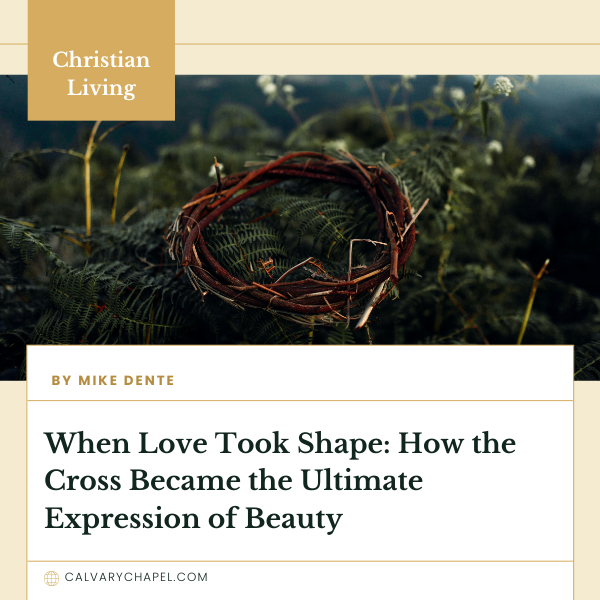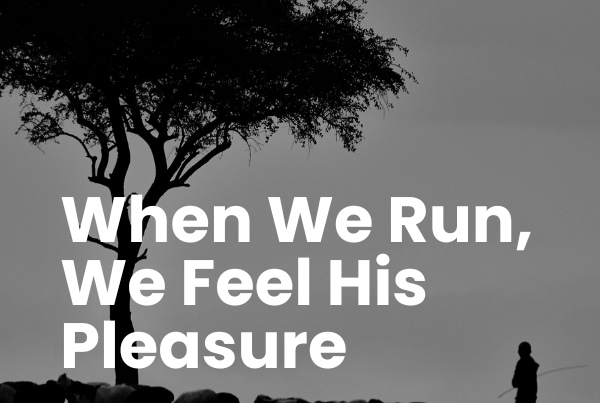
Not too long ago, I remember walking into a cathedral, weaving my way through the crowd to find a cross made of polished gold and precious stones reflecting the sunlight filtering through the stained glass windows above it. The materials were stunning but the ambiance brought the experience to a new level. Another breathtaking example was made of two cross beams outside Asheville, North Carolina, perched upon a hill, seen through a chapel that overlooks a forest below. Although it was made of much humbler materials, the artist and architect’s work visually harmonized God’s creation with man’s craftsmanship. I profoundly admire an artist who can capture the cross in a way that makes me stop in worship, and yet, it seems strange to me to beautify this ancient form of execution. The geometrical form isn’t that remarkable, with only two intersecting lines, but it’s horrifying to remember what it once represented.
A Symbol of Horror
In The Cross of Christ, John Stott reminds us of how surprising it was for people in the first century to hear that they worship a crucified man. In Roman pagan culture, worshiping a human figure wasn’t a problem. Still, crucifixion was such a degrading form of punishment that no one could imagine a crucified hero. Roman citizens were exempt from such an execution. The practice itself was regarded with complete contempt and horror. Stott describes a second-century artifact, an example of ancient graffiti in Rome, that ridicules Christians with a drawing of a crucified man with the head of a donkey and another standing below raising his arm in worship with the phrase scratched out, “Alexamenos worships God.”[1] It seems a far stretch from the magnificent cross pendants and necklaces found in Rome today.
Add to this the gruesome torture crucifixion inflicted on its victims. There was the humiliation of being paraded through the city and publicly executed at the town gates after being stripped naked. In the Mediterranean climate, it wouldn’t take long for the sun to have its full effect on the uncovered head and skin, coupled with the effects of dehydration from blood loss. Then we can imagine the humiliation of seeing one’s enemies mock, the prosecutors looking on with smug satisfaction, all the while the family stood helpless for hours waiting for their loved one to die. There was a great shame in being crucified; we remember Paul quoting to the Galatian church the curse of one hung on a tree (Galatians 3:13), and a curse written in the Law of Moses is no small weight to bear.
Fleming Rutledge observes, “We may think that it was easier for the early Christians to understand the cross than it is for us, and perhaps that is so, but at the same time, they had even more reason to hide their faces from it than we do because they knew what it entailed. They had to face, as we today do not, the contempt of their contemporaries who knew only too well what an object of disgust a crucifixion was. The logical thing for the early Christians would have been to glide past the passion as quickly as possible, portraying it as an unfortunate but incidental episode on the way to the resurrection.”[2]The crucifixion is a horrifying outrage that’s also the cornerstone of our faith. Not only did Christians not brush past it, but they focused on it as the moment of hope that changed everything. How, then, do we go from the instrument of shame to the cross as an expression of beauty?
To a Vision of Beauty
A lot can be said about beauty, from the popular adage “Beauty is in the eye of the beholder” to a massive volume on theological aesthetics. But when we come to the cross, I tend to recoil thinking about the evil of its practice. It has taken me a while to consider it as something truly beautiful. A friend suggested I read Hans Urs von Balthasar, who helped me come around.
My first takeaway is that divine beauty isn’t subjective, meaning it’s not the “eyes of the beholder” that matters. God is beautiful, the source of all that can be called truly beautiful, and anything we perceive as having beauty on earth is a reflection of His goodness. As in James 1:17, “Every good gift and every perfect gift is from above, coming down from the Father of lights, with whom there is no variation or shadow due to change” (ESV).
My second takeaway is the way God reveals His beauty through Jesus. Jesus as God is all that is beautiful: His Word, His deeds, His compassion, and His miracles. The Father’s revelation of Himself is an aimed, predetermined action that infuses beauty into our ugliness like someone turning on a light switch in a dark room. “That’s where we can also discover … what is truly beautiful, which is not produced by an enchantment of an exalted state of man but is delivering Himself.”[3] Or as Jesus said, “He who has seen Me has seen the Father” (John 14:9b).
Here’s what I find essential concerning the cross: When we look at it, the cross itself is nightmarish, ugly, and frightening. But what’s beautiful about the cross is not the wood. It’s not the human remains that have been brutally embedded into it through physical violence, nor even so much the sacrifice of a man. The beauty of the cross is love. It’s God revealing himself. It’s the One who’s so far outside the comprehension of man that He is showing him the deepest part of true love. Then, He proves at what point He is ready to bring heaven and earth as His audience to see what He will do to redeem His own.
Or consider one of Jonathan Edward’s expressions of divine beauty: “The highest expression of this goodness was the crucifixion of the Son of God. In the death of Jesus Christ, God showed His kindness and love to sinners on a scale only infinity could contain. “There never was such an instance of goodness, mercy, pity, and compassion,” Edwards asserted, for “this is goodness that never was, never will, never can be paralleled by any other beings.”[4] True beauty shines through in this moment as the Father reconciles us through the Son, who chose the cross. This is the beauty of sacrificial love, as it is impossible to replicate in the human sphere apart from God.
This makes the cross beautiful, where the best of our artistic renderings find inspiration and are humbled in reverent worship. The beauty of the cross is endless grace. It’s the nail-pierced hand of the Savior inviting us to come. The cross ends the moralistic message because it leaves no room for the try-harder approach, the at-least-I’m-not-like-that or better luck next time. The cross announces our death. But not a death without hope or salvation. We die with Jesus and are resurrected with Him, too. So we’re not forsaken because the cross also points to vibrant new life in the One who gave Himself for us. As read in Galatians 2.20, “I have been crucified with Christ. It is no longer I who live, but Christ who lives in me. And the life I now live in the flesh I live by faith in the Son of God, who loved me and gave himself for me” (ESV).
References:
[1] Stott, John R. W. The Cross of Christ. New ed. Leicester: Inter-Varsity, 1989. p 24-25.
[2] Rutledge, Fleming. The Crucifixion: Understanding the Death of Jesus Christ. Wm. B. Eerdmans Publishing Co. 2015. Kindle Edition. pp 84-85.
[3] Balthasar, Hans Urs von, Robert Givord, and Éric Iborra. Gloire: une esthétique théologique. Oeuvres complètes. Freiburg im Breisgau: Éditions Johannes Verlag, 2019. p 315 (personal translation into English).
[4] Strachan, Owen; Sweeney, Douglas Allen. Jonathan Edwards on Beauty (The Essential Edwards Collection Book 2). Moody Publishing. 2010. Kindle Edition. p. 38.







